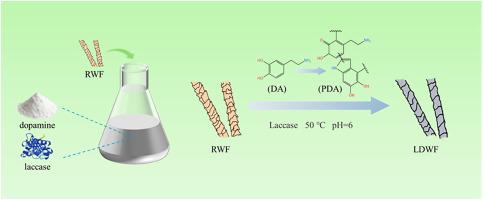Study on the coupling treatment of wool fiber with laccase/dopamine
IF 5.8
2区 化学
Q2 CHEMISTRY, MULTIDISCIPLINARY
引用次数: 0
Abstract
Wool, a natural protein fiber, is widely utilized in the textile industry due to its exceptional warmth retention and comfort. Nevertheless, the scale structure of wool fibers often results in felting shrinkage during processing and practical use. To address this, we propose a laccase/dopamine coupling treatment approach for wool fibers. Laccase, an eco-friendly enzyme, effectively removes scales from wool fibers. Concurrently, dopamine, a biomimetic material, is oxidized by laccase to form a polydopamine (PDA) coating on the wool fibers, thereby mitigating damage caused by scale removal. Through orthogonal optimization, key parameters were established: laccase concentration (1800 U/L), dopamine concentration (6 g/L), and treatment time (150 min). This optimized process significantly enhanced performance: breaking strength increased by 8.91 % (from 19.42 cN to 21.15 cN), and felting ball volume expanded by 19.62 % (from 14.73 cm3 to 17.62 cm3). The instrument analysis results demonstrate that laccase efficiently removes wool scales and collaborates with dopamine to establish a PDA coating, thereby augmenting the mechanical properties of the fibers. The effects of modification treatments on the dyeing properties and fastness of wool fibers, along with the long-term durability of the modified wool, were systematically investigated. In addition, aspects concerning the scalability, reproducibility, and commercial viability of the treatment process were discussed in detail. The laccase/dopamine coupling treatment method presents an eco-friendly strategy for wool processing, enhancing shrink resistance and mechanical properties while aligning with the principles of green chemistry and sustainable development, with broad application potential.

漆酶/多巴胺偶联处理羊毛纤维的研究
羊毛是一种天然的蛋白质纤维,由于其特殊的保暖性和舒适性,被广泛应用于纺织工业。然而,羊毛纤维的鳞屑结构在加工和实际使用过程中往往导致毡缩。为了解决这个问题,我们提出了一种漆酶/多巴胺偶联处理羊毛纤维的方法。漆酶是一种环保酶,能有效去除羊毛纤维上的鳞片。同时,一种仿生材料多巴胺被漆酶氧化,在羊毛纤维上形成聚多巴胺(PDA)涂层,从而减轻了除垢造成的损伤。通过正交优化,确定关键参数:漆酶浓度(1800 U/L)、多巴胺浓度(6 g/L)、处理时间(150 min)。优化后的工艺显著提高了性能:断裂强度提高了8.91%(从19.42 cN增加到21.15 cN),毡球体积增加了19.62%(从14.73 cm3增加到17.62 cm3)。仪器分析结果表明,漆酶有效地去除羊毛鳞片,并与多巴胺协同建立PDA涂层,从而提高纤维的力学性能。系统研究了改性处理对羊毛纤维染色性能、牢度及长期耐久性的影响。此外,还详细讨论了该处理工艺的可扩展性、可重复性和商业可行性。漆酶/多巴胺偶联处理方法为羊毛加工提供了一种环保策略,在符合绿色化学和可持续发展原则的同时,提高了羊毛的抗收缩性能和力学性能,具有广阔的应用潜力。
本文章由计算机程序翻译,如有差异,请以英文原文为准。
求助全文
约1分钟内获得全文
求助全文
来源期刊

Sustainable Chemistry and Pharmacy
Environmental Science-Pollution
CiteScore
8.20
自引率
6.70%
发文量
274
审稿时长
37 days
期刊介绍:
Sustainable Chemistry and Pharmacy publishes research that is related to chemistry, pharmacy and sustainability science in a forward oriented manner. It provides a unique forum for the publication of innovative research on the intersection and overlap of chemistry and pharmacy on the one hand and sustainability on the other hand. This includes contributions related to increasing sustainability of chemistry and pharmaceutical science and industries itself as well as their products in relation to the contribution of these to sustainability itself. As an interdisciplinary and transdisciplinary journal it addresses all sustainability related issues along the life cycle of chemical and pharmaceutical products form resource related topics until the end of life of products. This includes not only natural science based approaches and issues but also from humanities, social science and economics as far as they are dealing with sustainability related to chemistry and pharmacy. Sustainable Chemistry and Pharmacy aims at bridging between disciplines as well as developing and developed countries.
 求助内容:
求助内容: 应助结果提醒方式:
应助结果提醒方式:


